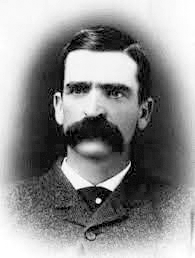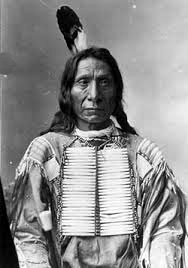






 This story is about an Indian chief who used intimidation and psychological warfare, more than warfare to keep the whites out of his land.
This story is about an Indian chief who used intimidation and psychological warfare, more than warfare to keep the whites out of his land.
Colorow was a 300-pound surly leader of a band of Northern Ute. His weight was the result of his love for biscuits covered in syrup, which he regularly got by intimidating settler housewives in the Denver area.
But Colorow wasn’t always that size. As a boy he was a Comanche captured by the Ute. However, because of his skills in battle and his leadership qualities, he was made a chief. Although Colorow never really declared war with the whites, he was a persistent thorn in their sides. In 1876 the Ute owned 32 million acres in western Colorado, and Colorow and his people made sure they kept it by threatening and intimidating any miners or settlers who entered the area.
In 1878 a new Indian agent arrived in town. Agent Nathan Meeker’s objective was to transform the Ute into farmers. At the same time Colorado elected a governor on the platform that “the Utes must go.” It was only a matter of time before the sparks lit the gunpowder. And it happened when Meeker, fearing an uprising…because he cut the Ute’s rations to a bare starvation point…called in troops. Colorow ambushed the troops, killing 13, and wounding 43. At the same time another group attacked Meeker’s family, and killed all of them. A truce was arranged. And the Ute who killed the Meekers were punished, but Colorow’s attack was considered an engagement of war.
Again in 1887 a skirmish broke out. As with the one before, it was needless. This one ended when both sides ran out of ammunition.
Finally, on December 11, 1888, Colorow died. It has been estimated that Colorow’s persistent psychological intimidation of any white entering the Ute lands probably delayed the settling of the central Rocky Mountains by at least a decade.
 In the Old West there were men who seemed to be everywhere and do everything. Today you’re going to be introduced to one of those men. His name is Seth Bullock.
In the Old West there were men who seemed to be everywhere and do everything. Today you’re going to be introduced to one of those men. His name is Seth Bullock.
In 1867, at the age of twenty, Seth Bullock left Canada to come down to the Montana Territory and do some gold mining. Four years later he was elected to the territory’s state senate. Next Seth took a horseback ride around the Yellowstone area, and sent back reports that helped influence its becoming our first National Park.
Then he became a county sheriff and proceeded to face down a lynch mob, as well as legally hang the first man in the Montana Territory.
Deciding to move on to new territory, he went to Deadwood in 1876. With no law, and no official process of selecting a sheriff, by popular demand, he became the town’s first lawman.
Also being a good businessman, he served as the president of a mining company and a bank.
As a lawman, while trailing an outlaw named Crazy Steve, he ran into a posse led by a deputy U. S. Marshall from the Dakota Badlands who had just caught Crazy Steve. The U. S. Marshall and Seth became lifelong friends. Incidentally, the marshal’s name was Theodore Roosevelt.
Although Seth became a captain in Roosevelt’s Rough Riders, he was never sent to Spain.
After Roosevelt became the President, he sent for Seth, and told Seth that he was needed in Washington. Seth responded that, “There’s just one job that would get me to live in this town, and you’re filling it just fine.” Seth settled for the job of a U.S. Marshal.
Seth served with distinction until his death on September 23, 1919. Roosevelt had called Seth Bullock the ideal American. But he wanted only one word on his tombstone…Pioneer.
 Do you think you’ve had a rough life? I can assure you that when we get through with the story of Elizabeth Ann Clifton; you’ll feel your life is a piece of cake.
Do you think you’ve had a rough life? I can assure you that when we get through with the story of Elizabeth Ann Clifton; you’ll feel your life is a piece of cake.
Born in 1825, Elizabeth Ann Clifton had no schooling and suffered with bouts of epilepticy. At the age of sixteen, she married Alexander Carter. They became ranchers outside of Dallas. Elizabeth managed the ranch, and ran a boarding house. Her husband and his father ran a freight company. In 1857, both her husband and his father were mysteriously killed.
A little over a year later Elizabeth married a Lieutenant Sprague. He disappeared eighteen months later. Elizabeth continued with the boarding house and ranch, becoming one of the most prosperous people in the area. At the age of 36, Elizabeth married a third time…one of her ranch’s cowboys. They were married a year and a half when he was murdered.
Surviving three husbands was tough enough to bear. But the worse was yet to come. In 1864, when she was 39, her ranch was attacked by Comanche, during which Elizabeth’s daughter and daughter’s son were both killed. Elizabeth, her thirteen-year-old son and two surviving granddaughters were taken captive.
Elizabeth was sold to the Kiowa. One of her granddaughters froze to death during the winter of 1864. The other spent nine months as a captive. The Comanche tattooed her arms and forehead before releasing her.
After spending twelve months in captivity, Elizabeth was rescued. And on August 27, 1866, at the age of 41, she headed home. Elizabeth reunited with her granddaughter. Three years later, she married again, and lived quietly until her death at the age of 57.
Truly, it took strong women to survive in the Old West.
 As you will see this week, one of the few times Red Cloud made a miscalculation in his fight with the whites was on August 2, 1867.
As you will see this week, one of the few times Red Cloud made a miscalculation in his fight with the whites was on August 2, 1867.
In July of 1867 civilian contractor J. R. Porter arrived at Fort Kearny in Nebraska with supplies. He planned on starting a logging operation. Among the supplies were 700 new breech-loading Springfield rifles and 100,000 rounds of ammunition. Until now the military had used muzzle-loading rifles. A Springfield used a manufactured cartridge, making it several times faster to shoot than a muzzle-loader.
Porter built his logging camp about six miles from the fort. To carry the logs he took the box beds off about 14 wagons, putting the four-foot high wagon boxes in a circular corral for protection.
At dawn of August 2, 1867 Red Cloud, with almost 1,000 braves, was poised for an attack against the 32 men inside the circle of wagon boxes. Even the women and children of the tribe, had come to observe the event.
At 9:00 500 warriors on horseback made the first charge. They circled the wagons expecting the spaced firing of a muzzle-loader. Instead it was the constant volley of the Springfield. The warriors retreated. Dead and wounded Indians and horses were everywhere. The next wave was 700 warriors on foot wearing nothing but war paint. The Indians got so close and the Springfields were so powerful that one shot often passed through two or three warriors.
For three hours the battle waged on. Then the sound of a howitzer was heard in the distance. A relief column was on its way. Red Cloud and his tribe retreated into the hills.
Miraculously, only 7 of the soldiers and loggers were killed. However, Red Cloud lost over 200 braves.